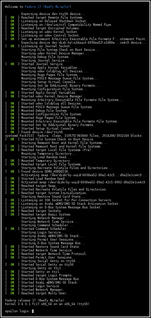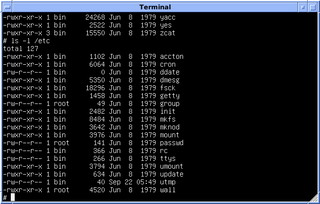
In computing, a system call is the programmatic way in which a computer program requests a service from the kernel of the operating system it is executed on. This may include hardware-related services, creation and execution of new processes, and communication with integral kernel services such as process scheduling. System calls provide an essential interface between a process and the operating system.

A kernel panic is a safety measure taken by an operating system's kernel upon detecting an internal fatal error in which it either is unable to safely recover or cannot have the system continue to run without having a much higher risk of major data loss. The term is largely specific to Unix and Unix-like systems. For Microsoft Windows operating systems the equivalent term is "Stop error", resulting in a bug check screen that presents the bug check code on a blue background in early versions of Windows, or on a green background on the Xbox One platform as well as in some Windows 10 builds.

In multitasking computer operating systems, a daemon is a computer program that runs as a background process, rather than being under the direct control of an interactive user. Traditionally, the process names of a daemon end with the letter d, for clarification that the process is in fact a daemon, and for differentiation between a daemon and a normal computer program. For example, syslogd is the daemon that implements the system logging facility, and sshd is a daemon that serves incoming SSH connections.
A runlevel is a mode of operation in the computer operating systems that implement Unix System V-style initialization. Conventionally, seven runlevels exist, numbered from zero to six. S is sometimes used as a synonym for one of the levels. Only one runlevel is executed on startup; run levels are not executed one after another.

Linux-VServer is a virtual private server implementation that was created by adding operating system-level virtualization capabilities to the Linux kernel. It is developed and distributed as open-source software.
On the classic Mac OS, extensions were small pieces of code that extended the system's functionality. They were run initially at start-up time, and operated by a variety of mechanisms, including trap patching and other code modifying techniques. Initially an Apple developer hack, extensions became the standard way to provide a modular operating system. Large amounts of important system services such as the TCP/IP network stacks and USB and FireWire support were optional components implemented as extensions. The phrase "system extension" later came to encompass faceless background applications as well.
Initng is a full replacement of the UNIX System V init, the first process spawned by the kernel in Unix-like computer operating systems, which is responsible for the initialization of every other process. Initng's website calls initng "The next generation init system".
Upstart is an event-based replacement for the traditional init daemon – the method by which several Unix-like computer operating systems perform tasks when the computer is started. It was written by Scott James Remnant, a former employee of Canonical Ltd.
Linux startup process is the multi-stage initialization process performed during booting a Linux installation. It is in many ways similar to the BSD and other Unix-style boot processes, from which it derives.

The Completely Fair Scheduler (CFS) is a process scheduler which was merged into the 2.6.23 release of the Linux kernel and is the default scheduler. It handles CPU resource allocation for executing processes, and aims to maximize overall CPU utilization while also maximizing interactive performance.
runit is an init scheme for Unix-like operating systems that initializes, supervises, and ends processes throughout the operating system. Runit is a reimplementation of the daemontools process supervision toolkit that runs on many Linux-based operating systems, as well as, the Mac OS X, *BSD, and Solaris operating systems. Runit features parallelization of the start up of system services, which can speed up the boot time of the operating system.

Shinken is an open source computer system and network monitoring software application compatible with Nagios. It watches hosts and services, gathers performance data and alerts users when error conditions occur and again when the conditions clear.

The Linux console is a system console internal to the Linux kernel. The Linux console provides a way for the kernel and other processes to send text output to the user, and to receive text input from the user. The user typically enters text with a computer keyboard and reads the output text on a computer monitor. The Linux kernel supports virtual consoles - consoles that are logically separate, but which access the same physical keyboard and display. The Linux console are implemented by the VT subsystem of the Linux kernel, and do not rely on any user space software. This is in contrast to a terminal emulator, which is a user space process that emulates a terminal, and is typically used in a graphical display environment.

The systemd software suite provides fundamental building blocks for a Linux operating system. It includes the systemd "System and Service Manager", an init system used to bootstrap user space and manage user processes.
On Unix-like systems, OpenRC is a dependency-based init. Since 0.25 OpenRC includes openrc-init, which can replace /sbin/init, but the default provider for the init program is SysVinit for OpenRC. As well as Linux, OpenRC can also be used on several BSD systems. It was created by a NetBSD developer, who started the Gentoo/FreeBSD project.

Void Linux is an independent Linux distribution that uses the X Binary Package System (XBPS) package manager, which was designed and implemented from scratch, and the runit init system. Excluding binary kernel blobs, a base install is composed entirely of free software, but users can access an official non-free repository to install proprietary software.

Windows Subsystem for Linux (WSL) is a compatibility layer for running Linux binary executables natively on Windows 10 and Windows Server 2019.










